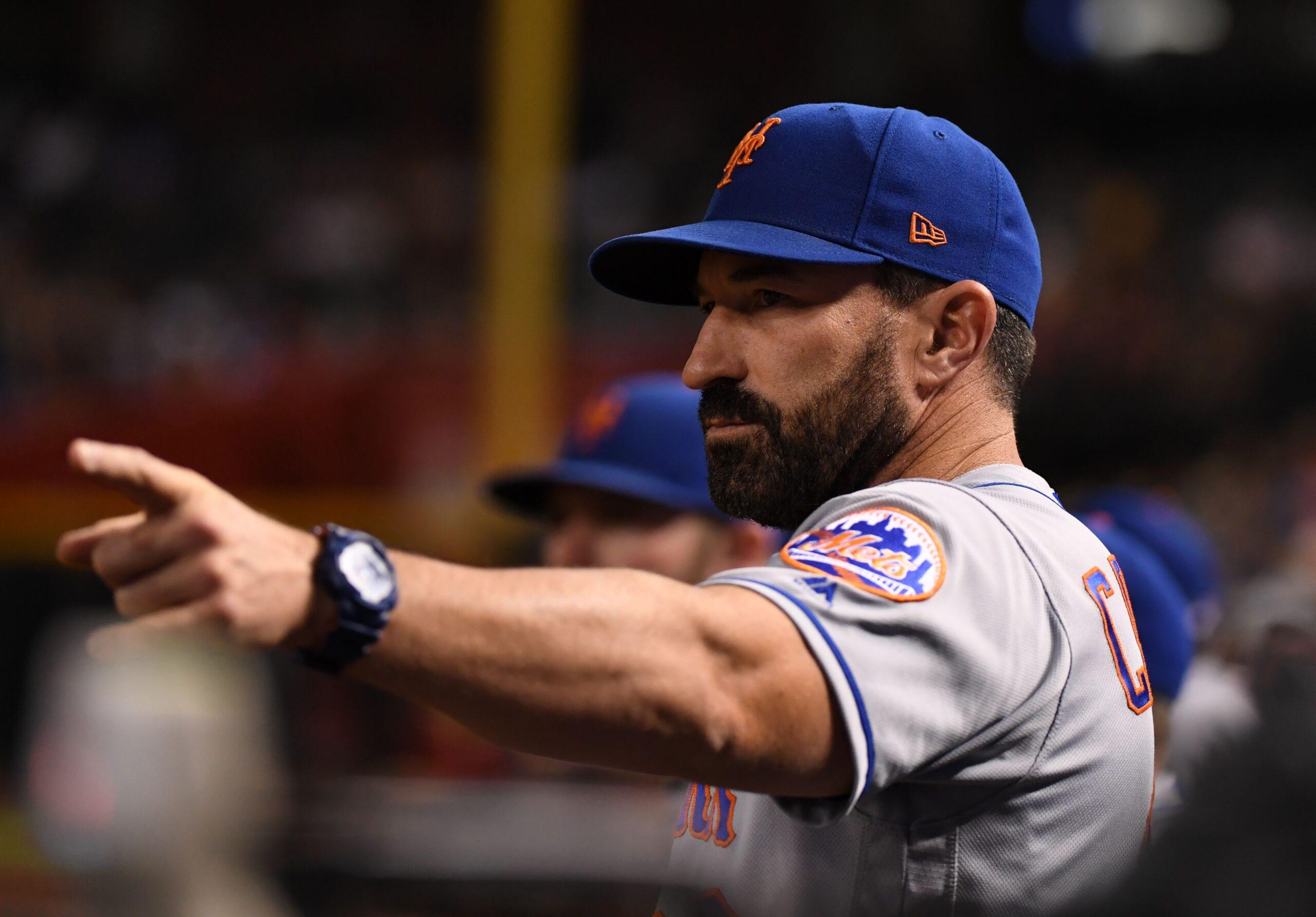New York’s hottest club is Citi Field. Inexplicably supported by legions of progressively more miserable New Yorkers, this electrifying house of horrors has it all: fines, staring matches, puppet master owners, conflicts of interest, devastating holes in the ground, and one (1) good thing, who has, at least in some quarters, made Mets games appointment viewing, which is great except for all the other things about the Mets.
Let us acknowledge, first, that the latest from the Mets is a baseball brawl in miniature: much huffing and puffing with comparatively little action to show for it. And second: Even for the Mets, baseball’s Picasso of creating bizarre dustups out of nothing, this is a masterwork.
You might have heard that the Mets are in the midst of some drama. Sunday’s kerfuffle began in the Wrigley Field visitors clubhouse after Newsday’s Tim Healey offered manager Mickey Callaway that classic provocation, the farewell that launched a thousand ships: “See you tomorrow, Mickey.” Callaway—already steamed after reliever Seth Lugo fell apart in the eighth inning, resulting in a 5-3 loss to the Cubs—apparently felt that Healey was mocking him, and he replied, in earshot of numerous players and other reporters, “Don’t be a smart ass,” and, after walking away, called Healey a “motherfucker.” The manager then walked back to Healey, swore some more, and—as Healey attempted to explain that he had not intended to insult him—said, “Shut the fuck up, get out of my face. Get out of here.”
Things escalated further after Callaway, who is in his second season at the helm, asked Mets PR to remove Healey from the clubhouse. Pitcher Jason Vargas then engaged in a staredown with Healey, after which he took several steps toward the reporter, telling him, “I’ll knock you the fuck out, bro.” The two were separated by a group including SpongeBob enthusiast Carlos Gómez and Noah Syndergaard. Not long after, we received the team’s apology: “The Mets sincerely regret the incident that took place with one of our beat writers following today’s game in the clubhouse.” On Monday, Callaway and Vargas were fined $10,000 each but not suspended; Callaway subsequently seemed to defend his outburst, telling reporters, “Billy Martin punched a reporter one time … I’m a passionate guy about baseball, I’m a tough competitor.” (In a later meeting with reporters on Monday, shortly before the Mets game against the Phillies, he apologized for this reaction.)
What exactly infuriated Callaway on Sunday? It was, at least in part, his preceding scrum with reporters—a standard postgame Q&A that the league requires of all managers, win or lose, road or home. There, he was asked by Matt Ehalt of Yahoo Sports if, given the fact that Lugo coughed up three runs and the lead, he ought to consider using closer Edwin Díaz in five-out situations. This season, Callaway has shown himself to be reluctant to deploy Díaz for more than three outs, even in high-stakes situations, and Lugo, it’s worth noting, had successfully pitched two shutout innings two days earlier—but it was clear that he just didn’t have ye olde “stuff” on Sunday. To Ehalt’s question—one that was both reasonable and obvious, given what had just happened on the field—Callaway replied, “No, just because you think so? Absolutely not. We have a very good plan. We know what we’re doing and we’re going to stick to it.” That is: The manager of a professional baseball team is now at a point where he is both (1) making obvious mistakes, either out of stubbornness or incompetence or both, and then (2) flying into a rage when asked, uh, excuse me, sir, that obvious mistake you made—why?
There have been what might charitably be considered hints that all is not well in Callawaydom. In May, Callaway told reporters that Díaz would be available for that evening’s game, despite his having pitched in four of the preceding five; Díaz told reporters himself that, in fact, he was not available. Last week, the manager rationalized bringing Robert Gsellman into an eight-run game by wanting to spare ace Jacob deGrom from being charged for any runners on base—even though there were no runners on base. When the Mets called a press conference in May—just after the team was one-hit by the Marlins—so certain did the impending firing of Callaway seem that the main headline was that no, he has the team’s utmost confidence.

These things, and the Mets’ 2019 strategery generally, are not necessarily Callaway’s fault, or at least not solely his. Owners Fred and Jeff Wilpon have a reputation for micromanaging their team’s day-to-day operations and have been accused of turning Callaway “into a literal puppet, telling him what to say and influencing who he plays,” per a recent report from The Athletic’s Ken Rosenthal. Still: Callaway’s Mets are 37-42 and in fourth place in the NL East; Baseball Reference currently gives them just a 13 percent chance of making the playoffs.
This team is, as any poor soul saddled with the misfortune of following it can attest, no stranger to calamity, much of it of the self-inflicted variety. Shall we run through the past year of Metsdom? There was the Mets almost blowing offseason contract negotiations with deGrom after a “miscommunication” led the team to believe their meeting with his agent was a day later than it really was. There was José Reyes being granted his lifelong dream to pitch last summer, only to give up five hits and six runs to the Nationals in a 25-4 loss. There’s been rotten injury luck—Yoenis Céspedes, seemingly just on the verge of recovering from his heel issues and beginning to play baseball again, tripping in a hole on his ranch and fracturing an ankle this spring (a debacle the team felt it was necessary to specify was not horse-related)—and apparently rotten management by trainers: Robinson Canó retweaked his left quad immediately after returning from the injury, and Syndergaard, struggling after reaching 102 pitches in his June 15 start, ultimately strained a hamstring, an injury from which he has still not returned. The team’s blockbuster December trade—Brodie Van Wagenen’s first big move as GM—for Díaz and Canó has looked worse and worse as its main goal, to give the Mets a fearsome bullpen, has foundered. The team currently leads the league in blown saves, while its relievers have baseball’s third-highest ERA; last week, the Mets fired both their pitching coach and their bullpen coach. (Yet another reason for a reporter to ask about bullpen strategy, and for a manager to expect as much!) Then there’s the presence of Van Wagenen, a former agent, and the curious conundrums his leadership has introduced: For instance, that the team attempting to recoup some of Céspedes’s contract could mean that the agent involved—you guessed it, Van Wagenen—would have to forfeit some of his commission. On Monday, the New York Post reported that Van Wagenen, while watching the game on television, relayed instructions to the Mets bullpen to remove deGrom from a game against Arizona earlier this month.
It’s not all bad: There’s Pete Alonso, of course, who has clobbered 27 home runs so far this season, putting him on pace for 56 by the end of the year. On Sunday, the rookie first baseman broke the Mets rookie record for home runs. But so dismal was the loss and its aftermath that Alonso said afterward, “We have got to flush it, turn the page.”
But the rest of it? Well. If it’s not Callaway’s fault, as the Mets continue to insist, then they might as well flush the whole team while they’re at it.
